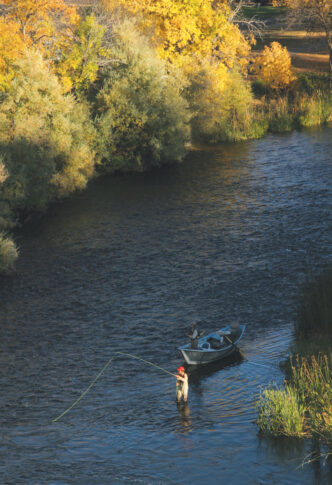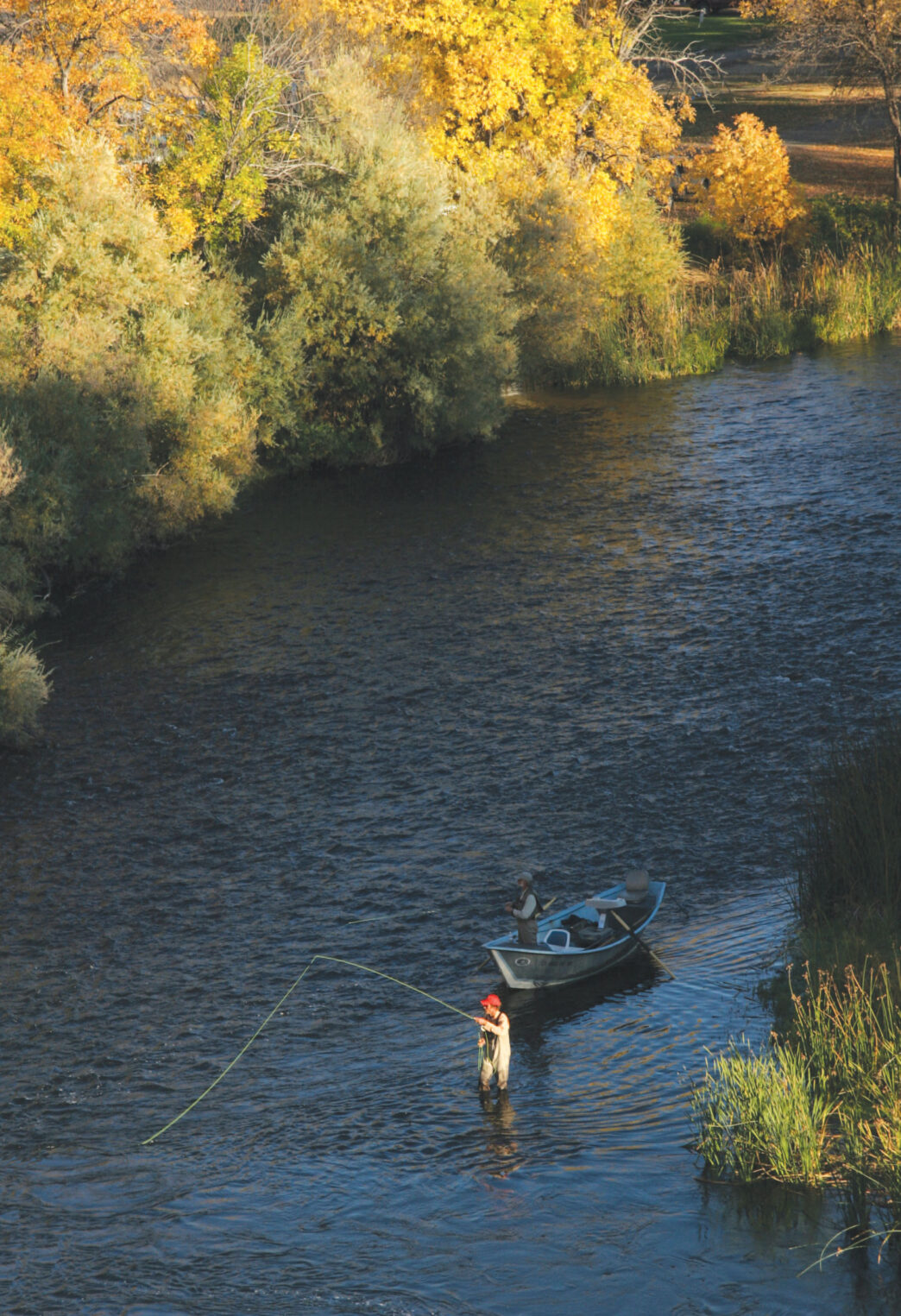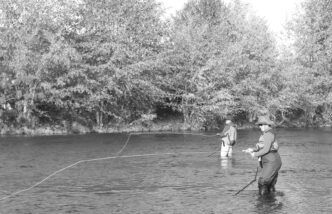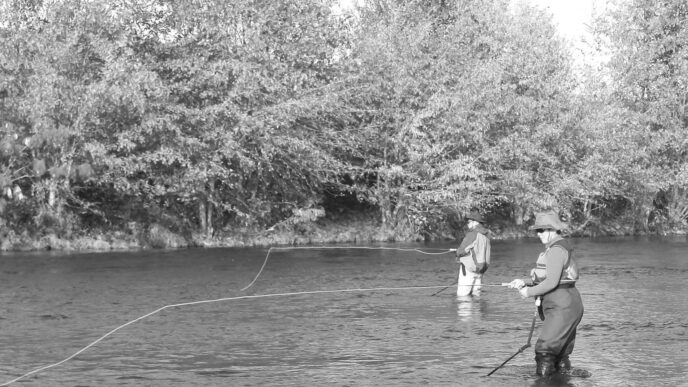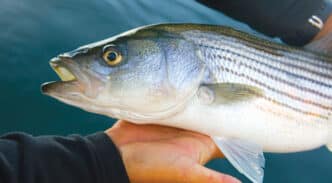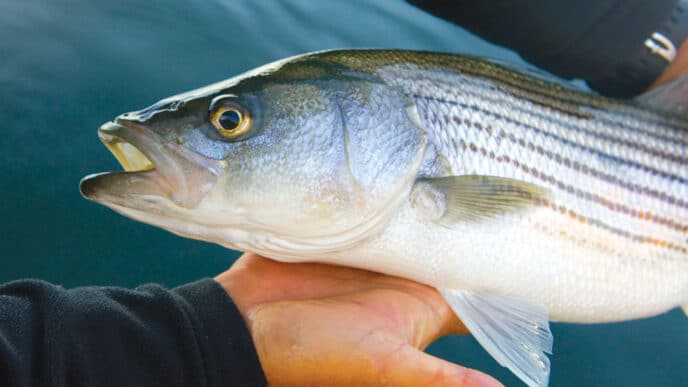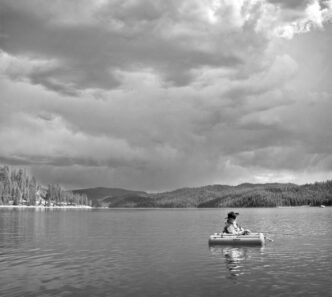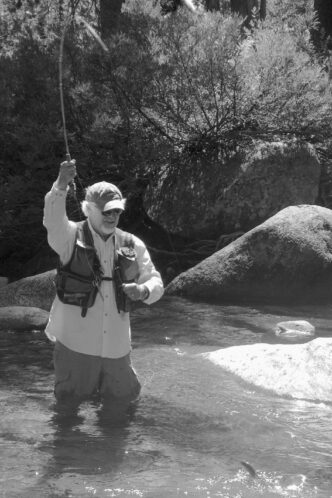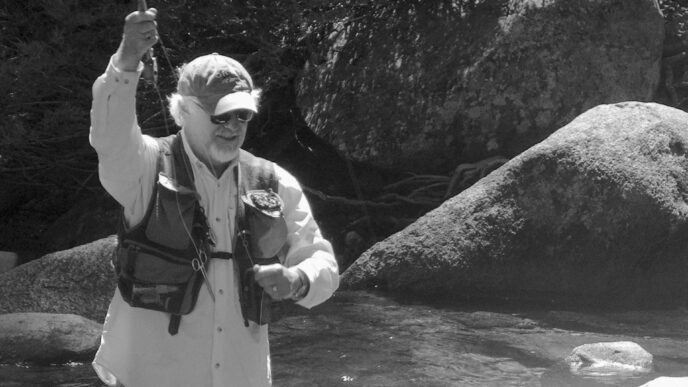The steelhead, some contend, is a fish of a thousand casts. This can be an understatement. Having chased these elusive creatures from California to Alaska for over 40 years, I have attained intimacy with the skunk in nearly all of its forms. Guiding for steelhead sometimes serves to intensify this stink. Guiding provides the distinct advantage of being on the river most days, following the fish, knowing their lies, and gaining some sense of their mood. Even when we find ourselves lucky enough to intercept steelhead in ideal conditions, there is still no guarantee that the most seasoned steelheaders and guides can entice them to eat.
I recently read a report that the average angling effort per steelhead caught by all sportfishing methods in California is a little over 30 hours per fish. This translates roughly into three and a half days of fishing for eight hours a day for each fish caught.
I know of no place where such a catch rate is less true than on the upper Klamath in autumn. Fly fishers are more likely to land at least several fish per day than get skunked. Because of this bounty and reliability, there may be no better time and place to discover the joys of fly fishing for steelhead than the fall season on the upper Klamath River.
The Fish
The Klamath’s steelhead start to enter fresh water in early summer. These chrome beauties are able to migrate over 190 miles upstream, where they are blocked by Iron Gate Dam. Waves of fish begin arriving in the upper river sometime in October, providing fishable numbers from below the dam downstream about 50 miles to the community of Seiad. New waves of fish continue to migrate upstream, with the number of fish increasing until the steelhead spawn in winter and spring.
The first steelhead to arrive in the upper river chase the fall chinook salmon run, feasting on eggs the salmon drop, along with the insects these enormous beasts dislodge as they prepare to spawn. The vast majority of this first wave of fish are the famed Klamath “half-pounders,” which have spent two seasons in fresh water and a few months in the salt. What they lack in size (they are typically 12 to 18 inches long), they make up for in attitude and abundance. Half-pounders take flies aggressively and are incredibly acrobatic. It is rare to land a fish without a few screeching runs and multiple aerial displays. Anglers experiencing half-pounders for the first time find them a hoot, but are stunned to discover the big trophy fish that fought so brilliantly turns out to be smaller in the net than they had imagined.
Often, after anglers successfully hook and land several of these charming, agreeable creatures, they encounter the real deal. Mixed in with the half-pounders in the early season will be a few adult wild steel-head that have spent an additional season in the salt, gaining the bulk that goes with it. These full-bodied brutes typically run three to six pounds, and if anglers are geared sportingly for half-pounders, these heavy, hot fish can prove to be a challenging change of pace.
Sometime in November, after the initial runs of fish have arrived, fin-clipped hatchery fish begin to show. Increasing numbers of fall-run wild adults typically arrive in the same wave, which includes some of the largest fish of the season. The bulk of these fish will be 22 to 26 inches in length, or three to six pounds. A few will be in the 6-to-10-pound range, and on rare occasions, a fish over 10 pounds will find an angler’s net. While these are not considered large compared with the fish in most other famed steelhead rivers, the numbers of fish and the diversity of the runs on the Klamath mean that anglers can find willing dance partners nearly every day of the season.
The Klamath also differs from most popular steelhead venues in the United States in that wild fish outnumber hatchery fish by a wide margin. In recent seasons, as hatchery returns have declined, some local guides report catching at least 20 wild fish for each hatchery fish landed. The bounty of the Klamath, along with studies that show that wild fish are more eager to take artificials than their cloned counterparts, may help explain continued angler success on the river while other steelhead fisheries have suffered.
Gear for Steelhead
Most seasoned trout anglers already own the gear they need to get started steelheading on the Klamath. A 6-weight rod with a matching reel and floating line is the most popular setup. Anglers focused on half-pounders sometimes opt for a 5weight, but find themselves undergunned for the occasional adult, while those targeting larger adult fish with 7-weights will learn that only the larger half-pounders are capable of putting a serious bend in the rod. If you have a quiver full of rods, play the game you choose. If not, realize that there is no perfect rod, and just enjoy the dance with the one you have.
The majority of fly fishers nymph with indicators, putting into practice trout tactics they’ve found to be effective on other California tailwaters. To floating lines they’ll attach a standard-taper 9-foot 2X or 3X leader with a tippet of the same test, an indicator, perhaps some split shot, and two or three flies. The most popular combination of flies is “legs and eggs,” though many standard nymph patterns, such as Pheasant Tails, Hare’s Ears, Prince Nymphs, and Copper Johns can be equally effective. Having an indicator system that easily adjusts to varying depths while moving from runs, to pockets, to ledges and drop-offs provides dividends in angling efficiency.
Increasingly, I’ve seen anglers arriving interested in swinging flies. In some ways, this represents a return to an era when nearly all fly fishers employed this technique. The “Klamath Swing,” where the fly is cast downstream and across with a floating line and then swung across the current in the river’s surface film or just beneath it, is a style of fishing a wet fly that had its origins here. Modern-day anglers can still find success with floating lines and classic wets, but having a sink-tip line often saves the day when the fish seem unwilling to move to the surface.
What has changed is that the majority of anglers now swinging flies are casting two-handed switch or Spey rods. Particularly in the fall on the Klamath, swinging can be more productive than nymphing, though perhaps from day to day it is not as consistently effective. One of the reasons is that the upper Klamath’s water clarity is moderately cloudy, a tea color that usually runs to three to five feet in visibility, which is ideal for swung flies.
Unfortunately, many of the twohanded rods I’ve seen employed are better suited to other venues, a bit too long and/or heavy to enjoy the majority of the water and fish encountered on the upper Klamath. With these bigger rods, it can be hard for half-pounders to show their stuff, and even small adults sometimes get cranked in after a jump or two. I have found switch rods and the lightest Spey rods available to be better matches, and most manufacturers now offer them in lengths and weights suitable for Klamath conditions. Rods comparable to a 6weight single-hander, or about a 4-weight Spey designation, are increasingly popular for good reason.
Until recently, finding lines other than a floating steelhead/salmon taper for these light rods was next to impossible. A number of manufacturers now offer Scandinavian and Skagit lines in the 200-grain to 400-grain weight designations that match well with the lighter rods.
Users of single-handed rods can swing flies with floating lines, sinking lines, sink-tip lines, or simply add one of the new sinkable poly leaders to gain depth when conditions warrant. That said, light twohanded rods offer anglers an opportunity to reach water where room for back casts is too cramped for single-handers.
The most popular and most productive flies for swinging continue to be dark classic wets. Silver Hiltons, Skunks, Mossbacks, or homespun designs in similar colors are the most consistent producers, while Brindle Bugs and Burlaps make for a nice change of pace and serve as follow-up flies for fish that have already been moved. When the fish are looking up, a skated caddis or Muddler can also get their attention (see, for example, the Klamath Caddis on page 48). Flies on floating lines are best attached to 2X or 3X tapered leaders about the same length as the rod in use.
Some anglers fish flies that have produced on other classic steelhead waters, but are a bit too big for the Klamath. Flies in hook sizes 8 to 12 will often elicit the most grabs here. Bigger flies, dark leeches two to four inches long, fished on sinking lines, may not get grabbed as often (fewer half-pounders play), but may be more effective in enticing the larger specimens to chase. Big flies are most commonly used with sink tips with three to five feet of tippet connecting the fly to the tip, and are most easily cast with two-handed rods. Again, the bounty and diversity of Klamath River steelhead allow anglers to choose the game they most enjoy playing and stand better than a fair chance of success.
Techniques and Tactics
The vast majority of fly fishers pursue steelhead on the upper Klamath from drift boats and rafts. Most often, the person on the oars slows the boat, while anglers on each side drift flies suspended under indicators down a run. When the tailout or end of the run is reached, the boat can be rowed back up an eddy and additional drifts down the run can be made. This is a commonly used tactic on trout tailwaters and is a highly efficient way on the Klamath to cover lots of water and locate lanes that are holding steelhead.
In the early part of the fall, when the chinook salmon are numerous, steelhead are not at all difficult to locate. They will reliably hold in the deep water and pockets downstream from the salmon and feast on the eggs that salmon drop, along with bugs dislodged from the substrate. During this time, anchoring the boat or wading to these areas is a popular strategy. Particular care should be taken to avoid anchoring or wading on the nests of eggs, or “redds,” the salmon build.
An interesting and exciting minor tactic during the salmon spawn is a variation on tight-line nymphing. Anglers cast indicators, quartering them upstream toward shore from the boat, but downstream of spawning salmon. Rather than attempting a drag-free drift, the angler keeps the fly line taught or perhaps mends it with a slight downstream arc, so the flies are moving ever so slightly faster than the current, keeping them from snagging the bottom. Takes are seldom subtle, and most often, as with swung flies, setting the hook is not required.
Wading anglers are increasingly discovering the joys of steelheading on the Klamath. Anglers are able to drive or boat to likely runs and wade into a position that allows them to cover as much quality holding water as possible. Anglers who are nymphing should first prospect the lanes closest to the near shore, then wade deeper and work their casts through successive lanes toward the far shore, adjusting the depth of their offerings as needed. Attaining the longest drag-free drifts possible is necessary, but it is also necessary to manage the line in a manner that enables the angler to detect a strike and set the hook quickly. Allowing the flies to swing up at the end of the drift will get a surprising number of fish to grab.
Wading anglers who prefer to swing flies often find themselves searching the same likely runs as nymphers, but they cover the water differently. They cast their flies toward the far bank and swing them back to the near shore, increasing the length of line and arc of each successive cast. Once the maximum casting distance desired is reached, swingers can take a step or two downstream, covering the run from top to bottom.
On the Klamath, the fly fisher can drift indictors through the long, deep runs and glides, tight-line nymph shorelines, and swing flies in tailouts, runs, and riffles with switch rods. All of these techniques will find fish.
Timing Your Trip
Almost every fly fisher I have met hopes to catch lots of fish, and big ones, too. I have already suggested that the Klamath may not be the best place to seek trophies, but with some of the strongest runs of wild fish in California, it is ideal for the angler looking for some steelhead action.
Fair-weather trout anglers looking to extend their season and explore steelheading will find the most comfortable weather conditions early in the fall season, during October and early November, along with the warmest water conditions, which helps keep the fish active. As mentioned earlier, most of the early arrivals are troutlike halfpounders, which provide a great deal of action and are ideal for those new to the sport. Unfortunately, these early arrivals also coincide with the end of the very popular fall chinook salmon fishing season and the corresponding aluminum hatch.
Late in November, as autumn progresses, the larger fish move in, but so does the winter weather, which along with dropping water temperatures can temper the bite, particularly for the half-pounders. If the goal is to seek out the larger fish and avoid the half-pounders and salmon anglers, though, later can be better.
Sometime late in December, winter weather and cold water temperatures set in for good. The fish remain, but require winter tactics to entice a bite. (See the companion article “Seasons on the Klamath: Winter” in the January/February 2010 issue of California Fly Fisher.) December is also the time that the constant flows from Iron Gate Dam can be disrupted by flooding and blow out the fishing, though these events are quite rare.
Klamath River Access
The upper Klamath River provides ample access for both wade anglers and boaters. There are over a dozen established launch sites from Iron Gate Dam downstream to Seiad, though many are rough affairs best suited for high-clearance four-wheel-drive vehicles. One of the easiest and most popular drifts is from the fish hatchery below the dam five miles down to Klamathon Bridge (known also as the Copco Ager Bridge), or as an alternative, another three miles down to the Interstate 5 bridge. Drifting the Klamath should not be taken lightly. There are numerous Class III and Class IV rapids downstream of Interstate 5, along with a great deal of structure that is not easy to see or read. Boaters accustomed to drifting the lower Sacramento,
Trinity, or Yuba have been spooked or worse when encountering these challenges.
Wading anglers will find little public access above the Interstate 5 bridge, but considerable access below, because Highway 96 parallels the river. A secondary road also follows the river on the opposite bank, from Ash Creek about 25 miles down to the community of Horse Creek. The Klamath River map published by Streamtime (available on-line at http://streamtime.com/publications.htm) can be a handy tool to find some of the launch sites and access points.
Conservation
The Klamath River remains one of the few rivers in the state of California with reasonably healthy runs of salmonids and provides perhaps the best opportunity to avoid the steelhead skunk. Although the runs are just a shadow of their historical abundance, the upper river flows through Siskiyou County, which is the size of Connecticut, but has a population of just over 40,000, so it doesn’t have the development pressure other steelhead rivers have suffered. The river is not without its challenges, which the largest freshwater fish kill in U.S. history in September 2002 demonstrated.
California Trout, Trout Unlimited, the Federation of Fly Fishers, and the Nature Conservancy, along with many other stakeholders, were pivotal in discussions to bring about a historic agreement to remove dams from the Klamath, beginning in 2020. We can only hope the fish will hang on long enough to realize the benefit of this. The Nature Conservancy has recently purchased property with prime spawning habitat on the Shasta River in hopes of restoring this important nursery and is negotiating water-use practices with landholders in an attempt to keep cold, clean water in the Scott and Shasta Rivers, which serve as important spawning and rearing habitat for steelhead and salmon. Support these organizations and their work with this watershed in every way possible. I hope that you will take the opportunity to contribute in a meaningful way, as well, so that our children and theirs might enjoy the bounty and beauty that the Klamath River provides.
Angling Regulations
All wild fish (indicated by intact adipose fins) must be released. In addition, the Klamath River is closed to angling for 3,500 feet below Iron Gate Dam.
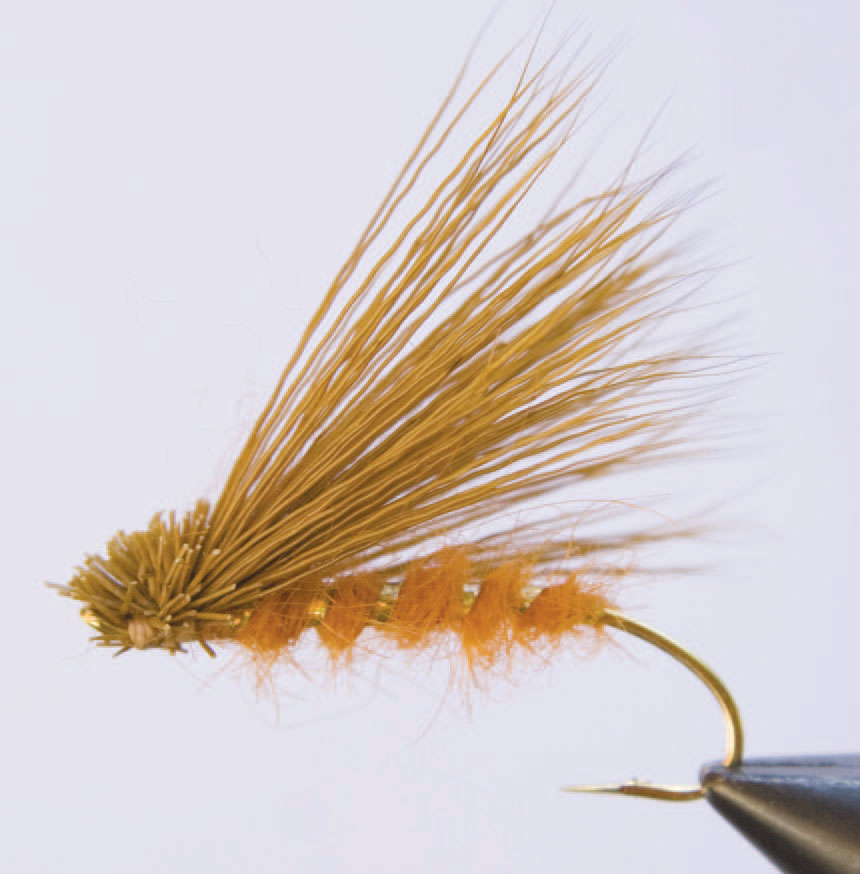
Klamath Caddis
Hook: Gold steelhead hook, sizes 8 and 10
Thread: Orange
Body: Orange seal dubbing
Rib: Gold flat tinsel
Wing: Elk hair dyed orange
If You Go…
There is little to be found in the way of amenities along this part of the Klamath River from its origins below Iron Gate Dam on down Highway 96, which follows the river downstream of the Interstate 5 bridge crossing. Most visitors base their trips out of Yreka, Ashland, or Mt Shasta. While Yreka is the closest town, it primarily features fast food and chain hotels. If you choose Ashland as a base, you’ll find lodging, dining, and entertainment options to rival any city of its size, but to reach the river, you’ll have to travel 25 miles south. The majority of local guides reside in Mt Shasta, where their guests often stay and make the drive 45 minutes north to the river. The list that follows encompasses only local businesses; there are other guides and shops that feature the upper Klamath as a destination.
Dining
Yreka. The Black Bear Diner: Features classic diner fare with fresh ingredients, friendly service, and huge portions, 1747 South Main Street, (530) 842-9324. Casa Ramos: A popular place for standard Mexican fare, along with Ramos family favorites and a full bar, 145 Montague Road, (530) 842-7172.
Ashland. Tabu: Fun and festive, with nuevo latino cuisine, 76 North Pioneer, (541) 482-3900. Thai Pepper: Excellent Thai cuisine and wonderful garden patio, 84 North Main Street, (541) 482-8058. Lela’s Cafe: An intimate bistro worthy of a splurge, 258 A Street #3, (541) 482-1702.
Mt Shasta. Trinity Café: Fine dining, superb service, and an excellent wine list, 622 North Mount Shasta Boulevard, (530) 26-6200. Vivify: Sushi and incredible Japanese cuisine in a relaxed elegant setting, 531 Chestnut Street, (530) 926-1345. The Black Bear Diner: Features classic diner fare with fresh ingredients, friendly service, and huge portions, 401 West Lake Street, (530) 926-4669.
Lodging
Hornbrook. Klamathon Lodge: a full service log-style lodge on the banks of the Klamath River, accommodations for groups of 4 to 10 anglers, airport pickup in Medford available, contact Craig Nielsen of Shasta Trout for combo guide/lodge trips, craig@shastatrout.com, (530) 926-5763. Blue Heron RV Park: offers full hookups with water, sewer and 50-amp electrical, 3930 Copco Road, (530) 475-3270.
Yreka. Best Western Miner’s Inn: Conveniently located within walking distance from downtown eateries, 122 West Miner Street, (530) 842-4355. Baymont Inn and Suites: 148 Moonlit Oaks Avenue (530) 841-1300; near the Black Bear Diner.
Ashland. Plaza Inn and Suites: Within walking distance of downtown dining, shopping, and entertainment, 98 Central Avenue, (541) 488-8900. The Ashland Springs Hotel:A historic hotel in the downtown center, 212 East Main Street, (888) 795-4545.
Mt Shasta. Mount Shasta Resort: Chalets on Lake Siskiyou, 100 Siskiyou Lake Boulevard (530) 926-3030. Best Western Tree House Inn: A short walk to town, 111 Morgan Way, (530) 926-3101.
Fly Shops
The Ashland Fly Shop, 399 East Main Street, Ashland, OR, (541) 488-6454; The Ted Fay Fly Shop, 5732 Dunsmuir Avenue, Dunsmuir, CA, (530) 235-2969; The Fly Shop, 4140 Churn Creek Road, Redding, CA, (530) 222-3555.
Guiding
Shasta Trout, Craig Nielsen, craig@shastatrout.com, (530) 926-5763; Three Rivers Guide Service, Alan Blankenship, alan@threeriversguideservice.com, (530) 925-7990; Andras Outfitters, Jim Andras, andrasoutfitters@me.com, (530) 722-7992; Wild Waters Flyfishing, John Rickard, john@wildwatersflyfishing.com, (530) 9263810; Mount Shasta Anglers, Chuck Volckhausen, chuck@mtshastaanglers.com, (530) 859-3474.
Shuttle Services
Sheri’s Shuttles, (530), 475-0931; Blue Heron RV Park, (530) 475-3270.
Craig Nielsen



